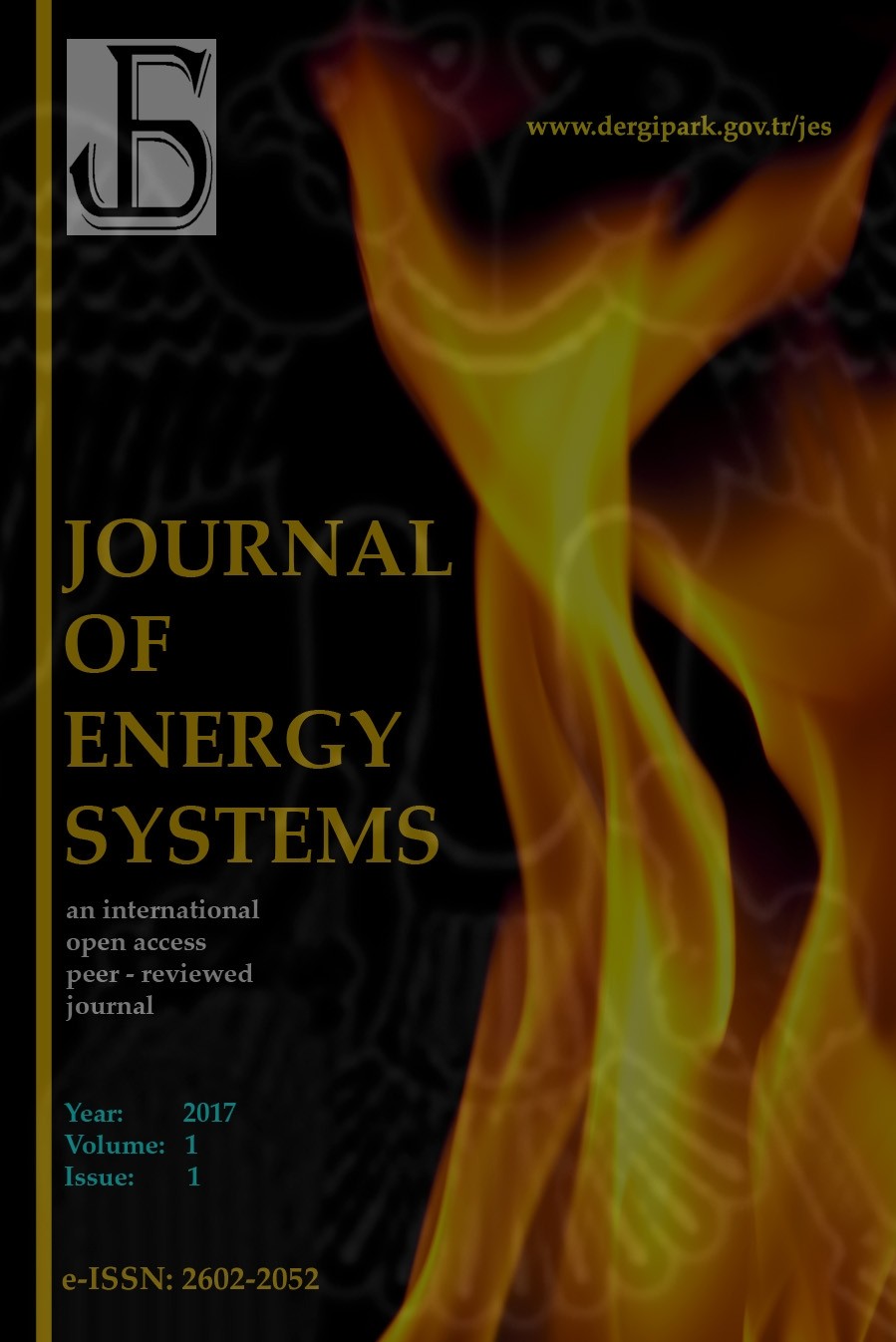Evaluation through finite element and numerical simulation of triboelectric polymer pairs in vertical contact mode
Evaluation through finite element and numerical simulation of triboelectric polymer pairs in vertical contact mode
Computational, Energy harnessing, Numerical Simulation, Triboelectric generator,
___
- [1] Bhamre, S, Mali, S, Mane, C. Optimization of electric vehicle based on triboelectric nanogenerator. In: E3S Web of Conferences 6th International Conference on Energy and City of the Future (EVF’2019); 28 May 2020: EDP Sciences, pp. 01027.
- [2] Bilgen, S, Kaygusuz, K,Sari, A. Renewable Energy for a Clean and Sustainable Future. Energy Sources 2004; 26(12):1119–1129, DOI: 10.1080/00908310490441421.
- [3] Qiu, C, Wu, F, Lee, C, Yuce, M. R. Self-powered control interface based on Gray code with hybrid triboelectric and photovoltaics energy harvesting for IoT smart home and access control applications. Nano Energy 2020; 70: 104456, DOI: 10.1016/j.nanoen.2020.104456.
- [4] Fatma, B, Gupta, S, Chatterjee, C, Bhunia, R, Verma, V,Garg, A. Triboelectric Generator made of Mechanically Robust PVDF Film as Self-powered Autonomous Sensor for Wireless Transmission Based Remote Security System. Journal of Materials Chemistry 2020; 8:15023-15033, DOI: 10.1039/D0TA04716C
- [5] Mahapatra, B, Kumar Patel, K, Vidya, Patel, P. K. A review on recent advancement in materials for piezoelectric/triboelectricnanogenerators.MaterialsToday: Proceedings 2020; DOI:10.1016/j.matpr.2020.09.261.
- [6] Askari, H, Hashemi, E, Khajepour, A, Khamesee, M. B, Wang, Z. L. Tire Condition Monitoring and Intelligent Tires Using Nanogenerators Based on Piezoelectric, Electromagnetic, and Triboelectric Effects. Advanced Materials Technologies 2018; 4: 1800105, DOI: 10.1002/admt.201800105.
- [7] Wu, C, Wang, A. C, Ding, W, Guo, H, Wang, Z. L. Triboelectric nanogenerator: a foundation of the energy for the new era. Advanced Energy Materials 2019; 9(1):1802906, DOI : 10.1002/aenm.201802906.
- [8] Wang, ZL, Lin, L, Chen, J, Niu, S, Zi, Y. Triboelectric nanogenerators. Basel, SWITZERLAND: Springer International Publishing, 2016.
- [9] Yoo, D, Go, E. Y, Choi, D, Lee, J. W, Song, I, Sim, J. Y ,Kim, D. S. Increased interfacial area between dielectric layer and electrode of triboelectric nanogenerator toward robustness and boosted energy output. Nanomaterials 2019; 9(1):71, DOI: 10.3390/nano9010071.
- [10] Baik, J. M, Lee, J. P. Strategies for ultrahigh outputs generation in triboelectric energy harvesting technologies: from fundamentals to devices. Science and Technology of Advanced Materials 2019; 20(1):927-936, DOI: 10.1080/14686996.2019.1655663.
- [11] Kim, D. W, Lee, J. H, Kim, J. K, Jeong, U. Material aspects of triboelectric energy generation and sensors. NPG Asia Materials 2020; 12(1):DOI:10.1038/s41427-019-0176-0.
- [12] Choi, D, Park, Y. T, Kim, S. H, Park, J. H, Woo, C. S, Lee, K. S, Kook, M. J. Nanogenerators in Korea. Korea: MDPI-Multidisciplinary Digital Publishing Institute, 2019.
- [13] Chen, A, Zhang, C, Zhu, G,Wang, Z. L. Polymer Materials for High‐Performance Triboelectric Nanogenerators. Advanced Science 2020; 7(14):2000186, DOI: 10.1002/advs.202000186.
- [14] Lee, L. H.Dual mechanism for metal-polymer contact electrification. Journal of electrostatics 1994; 32(1): 1-29, DOI: 10.1016/0304-3886(94)90026-4.
- [15] Lee, J. W, Ye, B. U,Baik, J. M. Research Update: Recent progress in the development of effective dielectrics for high-output triboelectric nanogenerator. APL Materials 2017; 5(7): 073802, DOI: 10.1063/1.4979306.
- [16] Barkas, D. A, Psomopoulos, C. S, Papageorgas, P, Kalkanis, K., Piromalis, D, Mouratidis, A.Sustainable Energy Harvesting through Triboelectric Nano–Generators: A Review of current status and applications. Energy Procedia 2019; 157:999-1010.DOI: 10.1016/j.egypro.2018.11.267.
- [17] Niu, S.,Wang, Z. L. Theoretical systems of triboelectric nanogenerators. Nano Energy 2015; 14: 161-192. DOI : 10.1016/j.nanoen.2014.11.034.
- [18] Abdelwahed, A, Amin, M, Elosairy, M, Abbasy, N. Theoretical modelling for enhancing contact-separation triboelectric nanogenerator performance :In 2016 Annual Connecticut Conference on Industrial Electronics, Technology & Automation (CT-IETA);14 October 2016:IEEE, pp. 1-5.
- [19] Shafeek, S, Luo, J. Theoretical and numerical analysis of triboelectric nanogenerators for self-powered sensors: In 2016 5th International Conference on Electronic Devices, Systems and Applications (ICEDSA) ;6 December 2016 : IEEE’UAE ,pp. 1-4.
- [20] Varghese, S, Shafeek, S, Kumar, R. S, Mini, R. S. Computational investigation of material combinations in triboelectric generators : In 2017 International Conference on Electrical and Computing Technologies and Applications (ICECTA), 21 November 2017: IEEE,UAE ,pp. 1-4.
- [21] Yu, Y,Wang, X. Chemical modification of polymer surfaces for advanced triboelectric nanogenerator development. Extreme Mechanics Letters 2016; 9: 514-530, DOI: 10.1016/j.eml.2016.02.019.
- [22] Uzun, Y., Kurt, E., Kurt, H.H. Explorations of displacement and velocity nonlinearities and their effects to power of a magnetically-excited piezoelectric pendulum, Sensors and Actuators A: Physical, 2015; 224, 119, DOI: 10.1016/j.sna.2015.01.033.
- [23] Lee, B.Y, Kim, D.H, Park, J, Park, K.I, Lee, K.J, Jeong, C.K. Modulation of surface physics and chemistry in triboelectric energy harvesting technologies. Science and technology of advanced materials 2019; 20(1): 758-773, DOI: 10.1080/14686996.2019.1631716.
- [24] Thainiramit, P, Yingyong, P, Isarakorn, D. Impact-Driven Energy Harvesting: Piezoelectric Versus Triboelectric Energy Harvesters. Sensors 2020, 5828, DOI: 10.3390/s20205828.
- Başlangıç: 2017
- Yayıncı: Erol KURT
Sujit BARHATE, Rohini MUDHALWADKAR
Modeling of doubly fed induction generator based wind energy conversion system and speed controller
Endalew HAİLE, Getachew WORKU, Asrat Mulatu BEYENE, Milkias TUKA
Shimna SHAFEEK, Sibgatulla SHARİEEF
Low density hemp shive particleboards for latent thermal energy storage performance
Edgars KİRİLOVS, Inga ZOTOVA, Silvija KUKLE, Kārlis PUGOVİČS
Dynamic analysis of a tri-floater with vertical axis wind turbine supported at its centroid
